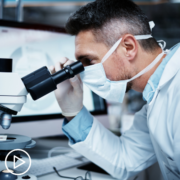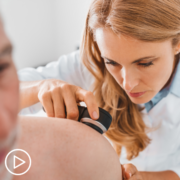Addressing Elevated Gastric Cancer Risks in Asian and Hispanic Communities
Addressing Elevated Gastric Cancer Risks in Asian and Hispanic Communities from Patient Empowerment Network on Vimeo.
How can higher gastric cancer risks for Asian and Hispanic populations be overcome? Expert Dr. Jun Gong from Cedar-Sinai Medical Center discusses H. pylori risk and screening and advice to patients to be proactive in their care.
[ACT]IVATION Tip
“…for the risk factors that are specific to the Asian and Hispanic populations is to understand the symptoms of H. pylori, which is one of the most common causes of stomach cancer, because they can be very effectively treated with antibiotics over a period of two weeks, oftentimes, and they’re very effective. This can be done at multiple provider levels from the primary care setting to the subspecialist setting. And also to know that symptoms, if they occur in family members that reside with the patient that is infected with h pylori or has stomach cancer, for them to be tested and the importance for their treatment as well.”
Download Resource Guide | Descargar guía de recursos
See More from [ACT]IVATED Gastric Cancer
Related Resources:

|

|

|
Transcript:
Lisa:
Dr. Gong, what can be done on an individual and systemic level to address the elevated risk for gastric cancer in the Asian and Hispanic populations?
Dr. Jun Gong:
To address the elevated risks for gastric cancer in Asian and Hispanic populations, I think it’s very important to understand what are probably some of the universal risks to both groups. And here, there’s been growing evidence that H. pylori infection affects both Asians and Hispanics and is one of the more pivotal risk factors to address on a systematic level. Here, there have been ongoing research where they’re just identifying H. pylori as a procedure and eradicating it with treatment.
This is usually with antibiotic containing treatment for about two weeks. And this imposes what we call a primary prevention method if we can actually eradicate one of the primary causes of stomach cancer. Is this the best way to address the greatest risk factor on a systematic level for Asians and Hispanics and other ethnic groups at high risk? On an individual level, I think again, this comes to tailoring what the diagnosis is with the respect of ethnicity of the patient and their cultural and their background as well as their familial background. Here, H. pylori, dietary lifestyle, hereditary causes are important to address, to minimize risk for stomach cancer.
And it’s also important to know that on the individual level, that family members that are living with patients with stomach cancer may also have what we call H. pylori incidence around the entire family. So it’s important to advise that sometimes your family members, because of the close living facilities and the shared utilities and restroom and how we dine together, that this shares a familial risk. And oftentimes it may need to be that your family needs to be treated if H. pylori is detected within the family as well.
Lisa:
So if a patient comes in and their family members are concerned, would it be advised that maybe their family members can go see their primary care provider and say, “Hey, my family member has gastric cancer. Will you test me for H. pylori? Is that…would that be a valuable question to ask?
Dr. Jun Gong:
So I think that raises the big question about should we systematically test all high-risk subgroups for H. pylori? And I think the jury is still out on that. There has to be formalized guidelines. What I recommend is family members who are with another family member that’s diagnosed with H. pylori and/or stomach cancer, if they are having any concerning symptoms of H. pylori infection, this is usually abdominal discomfort. It can actually be gastritis type symptoms of acid reflux. If you have any of those symptoms, then those are certainly indications for you to be tested either at the primary care level for H. pylori.
My activation tip for the risk factors that are specific to the Asian and Hispanic populations is to understand the symptoms of H. pylori, which is one of the most common causes of stomach cancer, because they can be very effectively treated with antibiotics over a period of two weeks, oftentimes, and they’re very effective. This can be done at multiple provider levels from the primary care setting to the subspecialist setting. And also to know that symptoms, if they occur in family members that reside with the patient that is infected with h pylori or has stomach cancer, for them to be tested and the importance for their treatment as well.












